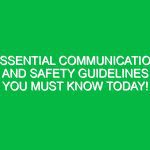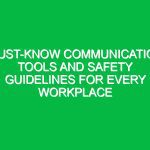Essential Tips for Effective Communication During Conflicts in HSE
Effective communication is vital in maintaining a safe workplace, especially during conflicts. In the realm of Health, Safety, and Environment (HSE), miscommunication can lead to serious Safety Hazards. Understanding how to address conflicts constructively ensures that Safety protocols are followed, promoting a culture of safety and compliance. This article provides essential tips for navigating conflicts related to HSE, highlighting common workplace scenarios, safety protocols, and fostering an environment of open dialogue.
Understanding Conflict in the Workplace
Types of Conflicts in HSE
Conflicts can arise from a variety of sources in the workplace, including disagreements over safety Procedures, resource allocation, and varying perceptions of risks. For example, consider a construction site where a worker feels that Safety Measures are being overlooked by a supervisor. This conflict may stem from misunderstandings of the safety protocols, potentially leading to hazardous situations if not addressed promptly. Recognizing the types of conflicts, such as interpersonal disputes or procedural disagreements, is crucial for effective resolution.
Open-ended question: Have you experienced a similar conflict at your workplace? What was the situation, and how was it resolved?
Effective Communication Strategies
Active Listening
Active listening is a critical component in resolving conflicts effectively. It involves fully concentrating, understanding, and responding to what is being said. In an HSE context, this means listening to concerns about safety without interruption. For instance, if an employee raises concerns about inadequate protective gear, the supervisor should acknowledge the concern, ask clarifying questions, and ensure the employee feels heard. This not only defuses tension but also opens the door to collaborative problem-solving.
Open-ended question: What techniques do you use to ensure you are actively listening during a safety discussion?
Clear and Direct Communication
Clear communication is essential to prevent misunderstandings. Use straightforward language when discussing safety protocols and ensure that all employees understand their responsibilities. For instance, during a safety meeting, a manager should clearly outline the procedures for handling hazardous materials. Using visual aids and demonstrations can enhance understanding, especially for complex topics. Establishing a culture where everyone feels comfortable asking questions will also reduce conflicts and improve compliance.
Open-ended question: How can we ensure that safety communications are clear for all team members?
Building a Culture of Safety
Encouraging Open Dialogue
Creating an environment where employees feel safe to voice their concerns is crucial for conflict resolution in HSE. Regular safety meetings and Toolbox Talks should incorporate a segment for employees to express their thoughts on safety practices. For example, during a Warehouse Safety meeting, the management could allocate time for employees to discuss any near-misses or unsafe conditions they’ve observed. This not only encourages participation but also helps identify potential Hazards before they result in incidents.
Open-ended question: What suggestions do you have for fostering an open dialogue about safety in our workplace?
Training and Development
Regular Training on conflict resolution and communication skills helps employees handle disputes effectively. These training sessions should include role-playing scenarios that simulate conflicts and practice effective resolution strategies. For instance, a hypothetical scenario could involve a disagreement over the use of Personal Protective Equipment (PPE). Employees can practice articulating their concerns while also learning to listen to opposing viewpoints. This proactive approach equips employees with the tools they need to manage conflicts, enhancing overall Workplace Safety.
Open-ended question: What topics do you think should be included in our next training on conflict resolution?
Conclusion
Effective communication during conflicts is essential for maintaining safety in the workplace. By understanding the types of conflicts, employing active listening, fostering open dialogue, and providing proper training, we can ensure that safety protocols are respected and adhered to. Remember, conflicts are not inherently negative; they can be opportunities for improvement. Let’s commit to applying these strategies daily to promote a safer work environment.
As a takeaway, consider how you can contribute to a culture of safety and effective communication in your workplace. Use this information in upcoming Toolbox Talks and safety meetings as a discussion starter, ensuring everyone is engaged in keeping our workplace safe.


